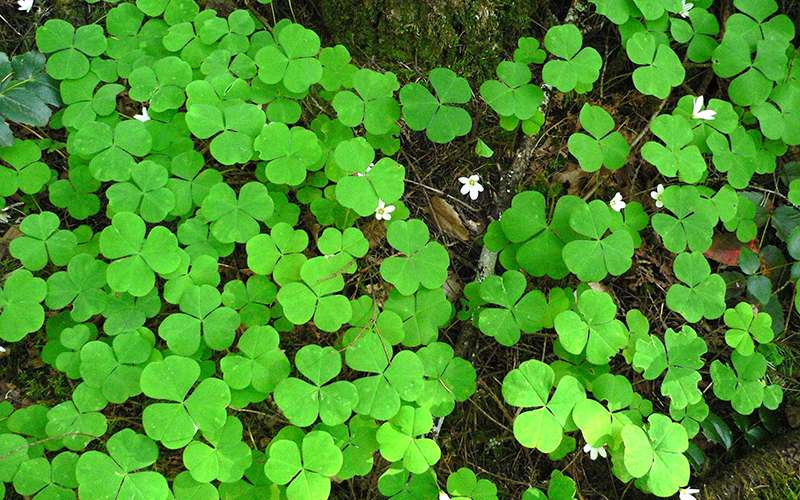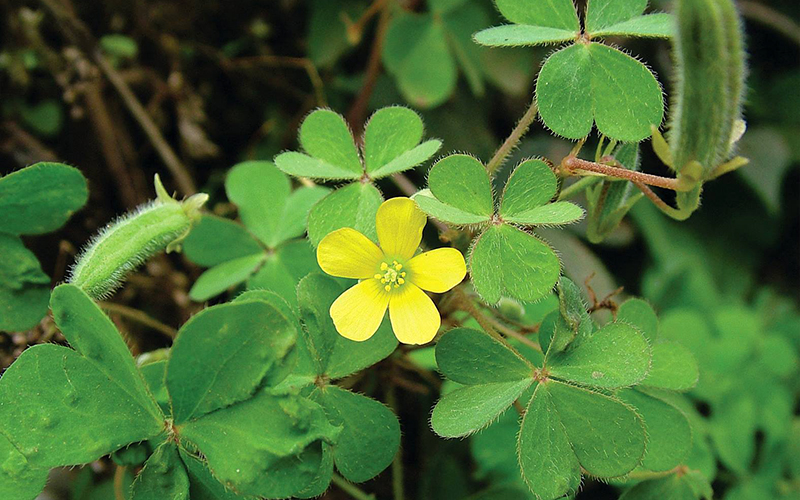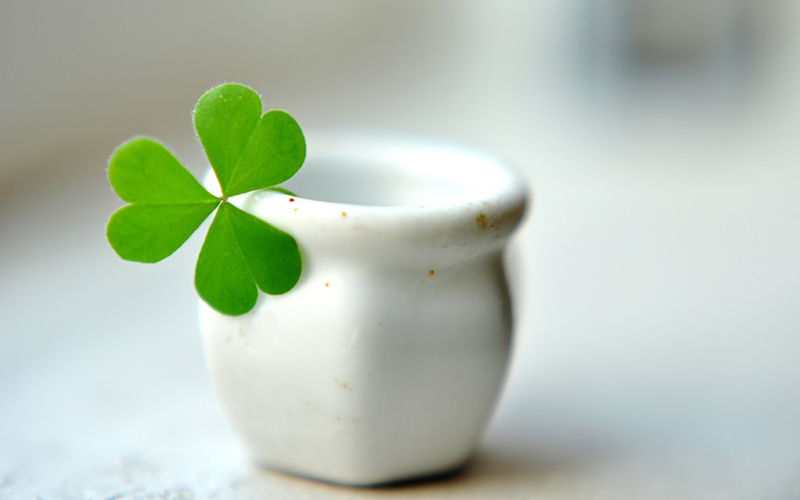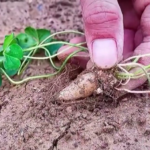Most of us have only heard of and sought out four-leaf clovers, believing that they bring good luck. However, not many people know that three-leaf clovers also hold significant meanings and bring wonderful things to our lives. So, what are they? Let’s explore and discover the fascinating world of three-leaf clovers in this article.
1 What is a Three-Leaf Clover? Its Unique Features
 As its name suggests, the three-leaf clover has three distinct leaflets that resemble a fan
As its name suggests, the three-leaf clover has three distinct leaflets that resemble a fan
The three-leaf clover, or Trifolium, is an herbaceous plant with an annual or perennial lifespan. What sets this plant apart is its unique trifoliate leaves, which resemble a fan and have a beautiful light green color. They appear delicate and fragile, but they possess an incredibly strong vitality.
Three-leaf clovers are predominantly found in temperate and subtropical regions such as Australia and Southeast Asia. In Vietnam, this type of clover can be spotted in the northern mountainous regions or in areas with a cooler climate like Da Lat in Lam Dong province.
For your reference: The Significance of in Feng Shui and Love
2 Types of Three-Leaf Clovers
There are mainly three types of three-leaf clovers: Oxalis (wood sorrel), Ipomoea aquatica (water spinach), and the lucky three-leaf clover.
Oxalis
 Oxalis, or wood sorrel
Oxalis, or wood sorrel
Oxalis, also known as wood sorrel, is commonly found in tropical regions with a hot and humid climate. Its flowers, belonging to the Photophilic family, are yellow or white and bloom during the day, closing at night. The leaves come in shades of green, purple, or a combination of both, and have a mildly sour taste. In traditional medicine, Oxalis is considered a valuable herb for its ability to cool the body and treat coughs in children.
Ipomoea Aquatica
 Ipomoea aquatica, commonly known as water spinach
Ipomoea aquatica, commonly known as water spinach
Water spinach, or Ipomoea aquatica, is a prevalent plant in moist, watery environments such as rice fields, rivers, and streams. Its roots grow in clusters, and it has thick stems and thin, airy leaves. Interestingly, it has four leaves, which often leads to confusion with the lucky four-leaf clover.
To distinguish between the two, one can look at the flowers. Since water spinach reproduces through spores and belongs to the fern family, it does not produce flowers. This plant is commonly consumed raw, cooked in soups, or used to make refreshing drinks.
Lucky Three-Leaf Clover
 The lucky three-leaf clover, believed to bring good fortune
The lucky three-leaf clover, believed to bring good fortune
The lucky three-leaf clover is often mistaken for the previously mentioned plants. It is believed to bring good luck and has the potential to develop a fourth leaflet, resulting in a four-leaf clover. This occurrence is due to a recessive genetic mutation.
The lucky three-leaf clover usually grows in clusters, and its flowers bloom in vibrant colors such as red, white, and purple. Interestingly, these flowers can be dried and used to make herbal tea.
3 The Significance of Three-Leaf Clovers
 Three-leaf clovers symbolize faith, hope, and love
Three-leaf clovers symbolize faith, hope, and love
Three-leaf clovers are associated with bringing luck, love, and happiness. Each of the three leaflets holds a distinct meaning: the first represents faith, the second hope, and the third love.
Additionally, if a fourth leaflet appears (as a result of a genetic mutation, creating a four-leaf clover), it symbolizes good fortune. These intriguing meanings have made three-leaf clovers quite popular among those who believe in their positive influence.
4 Benefits of Three-Leaf Clovers
Medicinal Benefits
According to traditional beliefs, three-leaf clovers offer several medicinal benefits, including:
Lowering Blood Pressure and Protecting Cardiovascular Health
 Three-leaf clovers help reduce blood pressure and protect the cardiovascular system
Three-leaf clovers help reduce blood pressure and protect the cardiovascular system
The presence of isoflavones in three-leaf clovers contributes to lowering blood pressure and protecting the cardiovascular system. Additionally, tea made from these clovers can reduce pressure in the arteries and blood vessels, further helping to decrease blood pressure. This also makes it effective in preventing coronary heart disease.
Boosting the Immune System
 Three-leaf clovers can effectively strengthen the immune system
Three-leaf clovers can effectively strengthen the immune system
Three-leaf clovers are rich in , which promotes the development of a robust immune system. This, in turn, increases the production of white blood cells, helping to reduce the occurrence of common seasonal illnesses.
Preventing Infections and Neutralizing Free Radicals
 The antioxidants in three-leaf clovers neutralize free radicals, preventing cell damage and mutation
The antioxidants in three-leaf clovers neutralize free radicals, preventing cell damage and mutation
The antioxidants present in three-leaf clovers can neutralize free radicals, which are known to cause cell damage and mutation. Additionally, the clovers contain the isoflavones daidzein, genistein, formononetin, and biochanin A, which stimulate the body’s resistance and help prevent infections.
Relieving Premenstrual Discomfort
 Three-leaf clovers help balance hormones and reduce breast pain during the menstrual cycle
Three-leaf clovers help balance hormones and reduce breast pain during the menstrual cycle
The isoflavones in three-leaf clovers help maintain stable estrogen levels, thereby balancing hormones throughout the menstrual cycle and reducing breast pain.
Aesthetic and Symbolic Benefits
 Three-leaf clovers add a touch of nature and positive symbolism to living spaces
Three-leaf clovers add a touch of nature and positive symbolism to living spaces
Many people choose to decorate their living spaces with three-leaf clovers to create a fresh and appealing atmosphere. These plants require minimal space and bring positive symbolism to one’s environment. People often keep pots of three-leaf clovers with the hope of attracting luck in various aspects of life, including love.
5 How to Grow and Care for Three-Leaf Clovers
Growing Three-Leaf Clovers
To grow three-leaf clovers, all you need is a small pot filled with airy and water-absorbent soil, such as peat moss or perlite. Simply fill the pot about two-thirds full with soil, spread the clover seeds evenly on the surface, and water lightly. That’s it!
Note: If you’re transplanting a wild three-leaf clover, simply place the plant in the pot and add a little soil around it.
 Three-leaf clovers are easy to grow and care for
Three-leaf clovers are easy to grow and care for
Caring for Three-Leaf Clovers
Caring for three-leaf clovers is simple. Maintain moderate moisture in the soil (water once a day) and place the plant in an area with moderate sunlight and a temperature between 20-25°C. During the germination phase, provide 3-4 hours of sunlight per day, and increase to 5-6 hours once the plant is more mature.
The odds of finding a four-leaf clover are 1 in 10,000. This does not mean you have to search through 10,000 three-leaf clovers to find one with four leaves.
We hope that through this article, you have gained a deeper understanding of the meaning, benefits, and fascinating facts about three-leaf clovers. If you’re intrigued by this charming plant, consider growing it yourself to add a touch of nature and positivity to your living space.
“Unlock the Secret to Ultimate Health: Discover the Wild-Growing Superfood Hiding in Plain Sight”
Introducing the humble yet powerful vegetable – an underrated nutritional powerhouse. Unbeknownst to many, this vegetable boasts an impressive array of health benefits, making it a secret weapon in any culinary arsenal. With its versatile nature and abundant advantages, it’s time to shine a spotlight on this unsung hero of the vegetable world.


































